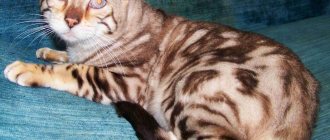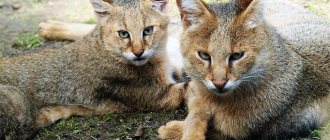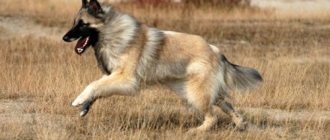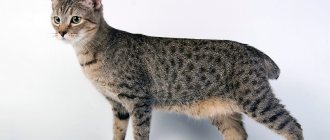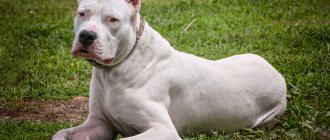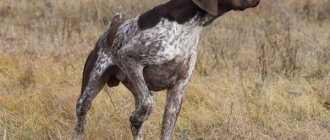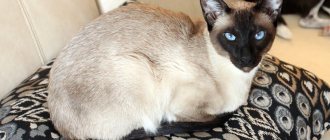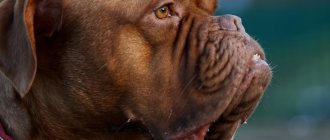With their appearance, Lyka cats created a sensation in the world of felinology. They are not the result of a genetic experiment, as one might think. Lykoi appeared as a result of natural mutations of a short-haired cat. In character and habits, they are no different from ordinary domestic purrs. Breeders claim that, despite its external resemblance to werewolves, the cat will definitely not begin to turn into a full moon.
Origin story
The birth of the breed is considered to be 2010, when a mongrel cat lambed on the farm of Patty Thomas (USA, Virginia). She got two strange half-hairless kittens. Believing that they were similar to the Canadian Sphynx, Patty contacted the famous breeders of this breed, the Gobble couple.
John Gobble became interested in unusual babies. After studying a large amount of information, Gobble came to the conclusion that the kittens are the result of a natural mutation. And I have already consciously received a second brood for future research.
The kittens were examined and no genetic abnormalities or skin pathologies were revealed. And the almost complete absence of fur and heavy shedding are the result of a lack of hair follicles.
DNA tests showed that the kittens have nothing to do with Sphynxes and Devon Rexes.
The Gobbles, making sure that the babies carried the genes of a natural mutation, prepared a breeding system. In the fall of 2011, the first representative of a new breed appeared , which was first called the possum cat because of the similarity of the wool to the fur of this animal. A little later, another name appeared - lykoy, or werewolf cat, due to its non-standard appearance and similarity to mystical creatures from horror films.
These cats are called werewolves because of their unusual appearance.
The breed was officially registered in the USA in 2012 and is recognized by the International Cat Association (TICA). Official breeding of Lykoi, issuance of documents and admission to exhibitions are not carried out by all clubs, but only by those that support the TICA charter.
Health and life expectancy
The experience of breeders and multiple tests have shown that in the breed at this stage the hairlessness gene is not associated with any pathologies or hereditary diseases. Lykoys can have any feline health problems, but, as a rule, they are caused by improper care, maintenance or nutrition.
Likoi were tested for selective diseases of the skin, heart, thyroid gland, blood, some infectious diseases, as well as hereditary diseases of the kidneys, liver and digestive tract common among cats. All results are negative, which suggests good health and good genetics.
Lykoi cats need the same vaccinations as regular domestic cats, as well as regular treatment for external and internal parasites. Use standard veterinary products. The breeders claim that they have never observed an allergic reaction to veterinary drugs, food or cosmetics.
Description and standard of the Likoi breed
Likoi is a partially hairless cat with a roan coat (alternating black and white guard hairs). Due to the newness of the breed, life expectancy is not precisely determined, as is height, but males are much larger than females.
Likoi belongs to the group of short-haired cats.
Table: description of the standard
| Options | Standard |
| Head | Wedge-shaped, with rounded lines from cheeks to nose |
| Muzzle | Medium length, ending with a pronounced rounded chin, vertically aligned with the nose |
| Nose | Wide, rounded at the end, pointing downwards |
| Eyes | Large, directed obliquely upward. Grey, blue, green or gold. |
| Ears | Set high, straight, triangular. The outside is covered with sparse hair. |
| Neck | Muscular, medium length |
| Frame | Compact, slightly elongated, thin build, medium bone. The back is curved in the shape of an arc. |
| Limbs | Medium length, may be hairless or sparsely covered with hair |
| Paws | Medium, oval-shaped with long fingers |
| Tail | Short, tapering to the tip |
| Leather | Pink, folded, sensitive to high temperatures. It turns black when exposed to sunlight and heat. After a few days without direct exposure to heat and sun, it acquires a natural color. |
| Wool | Soft, without undercoat, short to medium length, grows in tufts. The guard hair is long. Some individuals have no hair on the chest, belly and paws. |
| Color | Grayish-black or roan. White hair is evenly distributed on a black background throughout the body. The ideal ratio is 50 to 50%. |
| Weight |
|
The reasons for disqualification are:
- absence of hairless glasses and a mask on the face;
- all coat colors except black;
- lack of white hair;
- body completely covered with hair;
- presence of aggression or cowardice;
- strabismus;
- tail defects;
- congenital mutation of the fingers;
- blindness;
- cryptorchidism (undescended testicles) in adult cats.
Before the advent of the Lykoi, only horses could be roans.
Photo gallery: features of the Likoi breed
Lykoei's calling card is a hairless mask and glasses
Lykoi eyes can be any color, but it is preferable for them to be honey-gold
Likoi is the only cat breed in the world that has a roan (salt and pepper) color, or roan.
Kittens are born pure black, white hair appears later, after the first moult
Lykoi's fur is similar to that of an opossum.
Catering
Their diet should be balanced and satisfying: their metabolism is such that they want to eat often and in large quantities. And bare areas of the body contribute to accelerated heat exchange and a large waste of energy. But by overfeeding your cat, you will cause him to develop obesity, heart problems and diabetes.
Usually cats are fed 2 times a day. Likoev should be fed 5-6 times, giving small portions (taking into account the general weight recommendations). You cannot mix natural food and ready-made food: choose one. Otherwise, stomach problems cannot be avoided.
Likoi drink only water: clean, fresh and at a comfortable temperature (not ice, but not hot either). You should wash the bowl and pour fresh water in the mornings and evenings: squeamish cats will not drink dirty liquid.
Natural products
What should be on the menu at your lykoi? Since the cat is an obligate predator, meat is the determining product in its diet.
- Allowed: beef (nutritious, but a bit heavy), rabbit (hypoallergenic), poultry (chicken, turkey, quail), pork (shoulder, fillet, neck - small pieces), horse meat (nutritious and hypoallergenic), nutria (rich in vitamins), kangaroo meat, crocodile meat, snakes, mice, day old chicks. The meat is served raw (previously doused with boiling water), in small pieces, mixed with porridge or vegetables.
- Offal: heart, liver (boiled), ventricles, cartilage, necks, heads, tongues, lungs, testes, kidneys, spleen, tripe, udder.
- Fish: flounder, cod, haddock, navaga, pink salmon, herring, trout, carp, salmon, ivasi, omul, sockeye salmon. It is better to boil it, removing the fins and heads. Farmed fish are often laced with drugs. You shouldn’t buy it for either your cat or yourself.
- Cats get their fiber from vegetables. It helps the digestive tract function. It is allowed to give zucchini (raw and boiled), beets (boiled), cauliflower, broccoli, carrots, spinach. Many people enjoy gnawing on radishes and cucumbers. From fruits: melons, watermelons, pears, apples.
- Dairy products: biokefir and bifidokefir (fat content - 2-4%), low-fat cottage cheese, hard cheese, fermented baked milk, natural yogurt, sour cream diluted with water. If a cat has been drinking cow's milk since childhood and does not have a negative reaction (diarrhea, vomiting), you can continue to give milk.
- Boiled egg yolk and quail eggs.
- Porridge: rice, buckwheat, oatmeal, pearl barley.
You should not give smoked, rotten, salted, fried, smoked, spicy or fatty meat. It is forbidden to feed wild bird meat (almost always infected with parasites) and lamb (poorly digested).
Recommended food
If you want to feed Lykoya with ready-made food, choose the Holistic line. It includes the following foods: Riverwood, Gather, Go Natural. Holistics deserve their high praise due to their good composition. Super-premium food is somewhat lower in quality, but cheaper. The rest - premium and economy - are poor in composition.
Below are the recommended holistic class foods. Links with the names of the food are clickable, on them you can, within our website, get acquainted with the descriptions of the food and read reviews from owners of Likoi cats.
| Holistic | Holistic | Holistic |
| Acana | Nutram | Primordial |
Character and behavior
The frightening appearance of Lykoi masks their strong attachment to their owners. They like to be the center of everyone's attention. And due to their high intelligence, animals easily remember the rules of behavior in the apartment.
They treat strangers with distrust and rarely let them in, but once they find out that the guest does not pose a threat to the hosts, they make contact. At the hint of danger, they rush at the offender no worse than a dog, and the large size of the enemy does not bother them.
Werecats, especially kittens, are hyperactive, so older people and families with small children should refrain from purchasing such a pet. The attitude towards dogs and other cats is neutral, but Lykoi are natural hunters, so in the apartment you will have to cover the aquarium and hide cages with small rodents and birds.
Breeders have noticed that Lykoi sometimes “pray” - they freeze in the gopher pose, with their paws folded on their chest. They spend long minutes in this position, staring into the vast distance.
Video: Lykoi kittens
Maintaining a Lykoya House
Catwolf is contraindicated for families with small children, elderly people and those who have a lot of small animals at home (it will exterminate rodents and birds flickering in front of it).
These hyperactive cats are recommended for energetic and balanced owners who are able to pacify the restless nature of the Lykoei.
Care and hygiene
These semi-mangy creatures shed intensely, and hair loss is not necessarily associated with the season. A cat either goes bald or grows hair several times a year: the new coat may be darker or, conversely, lighter than the old one. Hair may appear in areas where it did not grow before.
This is interesting! It’s a paradox, but Lykoi love to be combed and are ready to expose their sides endlessly.
Another feature of the catwolf is that its folded skin reacts to light and heat, becoming covered with dark pigmentation (partial or complete) from sunlight or when sleeping for a long time on a hot radiator. But, as soon as the source of high temperature is removed, the skin returns to its natural pink color.
Werecats do not like water very much, but they need bathing, as a coating of sweat appears in the areas of alopecia. An alternative to washing are wet wipes. The ears and eyes of Lykoi are examined daily, cleaned if necessary.
What to feed a werecat
The catwolf eats a little more than other cats, since heat exchange in its body is accelerated (in this it is similar to many hairless breeds). That is why these animals are fed more often and more densely, but within reasonable limits: overeating leads to obesity and disease.
When choosing finished products, look for food for exotic breeds. A natural diet is formed based on your cat's preferences.
Diseases and breed defects
Breeders did a lot of work to identify hidden anomalies in the new breed, but they failed . The result of various tests, both genetic and veterinary, was an optimistic conclusion - Lykoi are not prone to somatic, dermatological, infectious and other congenital diseases.
Ultrasound and other laboratory tests complemented the picture, showing that Lykoi had healthy blood vessels/heart from birth and high vitality in general.
Education and training
Again, due to the novelty of the breed and the small number of its representatives, almost nothing is known about the methods of training werecats. The only thing that is not in doubt is their similarity to guard dogs, which initially do not trust strangers.
This is interesting! Lykoi owners are convinced that with targeted training, their dexterous and intelligent cats can easily take on the functions of a home guard, suddenly and viciously attacking an uninvited guest.
If you intend to go out into the yard with fun, get a collar with a leash, or better yet, a harness . The cat is accustomed to unusual equipment at home, and only after it stops paying attention to the “harness” is it taken outside.
Before a walk, make sure that the cat will not jump out of the harness/collar, and never carry the cat in your arms. Werecats are extremely evasive and agile: if they slip out, they can get lost forever.
Return to content
Maintenance and care
Lykoi are adapted to living in an apartment, they are clean and tidy. An important point in maintenance is coat care. Bare areas of skin often sweat, so when plaque forms from sweat secretions, they are immediately wiped with a damp cloth or the animal is completely washed. A kitten is taught to wash itself immediately after acquisition, since kittens are afraid of water.
Lykoi shed constantly, regardless of the season, and during the year they can completely lose their hair and grow it back several times.
Animals of this breed are prone to hypothermia, so the beds are located away from drafts. When the temperature drops, put warm cat clothes on your pet.
General recommendations for caring for Lykoyas are the same as for cats of other breeds:
- As the eyes become sour, wipe them with a cosmetic cotton pad soaked in boiled or filtered water. Tea leaves cannot be used for the procedure.
- The ears are washed once a week with a special lotion purchased at a veterinary pharmacy. Then gently dry with a cotton pad. Cotton swabs are not used due to the special structure of the cat's ear.
- The claws (only the tips, so as not to damage the pulp) are trimmed with a nail clipper as they grow.
- Brush once every 3 days, daily during active shedding.
Lykoya can and should be walked, but only on a harness. At any moment, the hunting instinct can be triggered, and the pet can get lost.
Nutrition
For balanced nutrition, high quality feed is selected in accordance with the age of the animal. The final choice of food is made taking into account the recommendations of veterinarians and individual tolerance.
Table: dry food suitable for complete nutrition of Lykoi
| Feed | Class | Manufacturer | Purpose | pros | Minuses |
| Orijen Cat & Kitten | Holistic | Canada | For adults and kittens, food with a high content of protein (42%) and fat (20%) | Suitable for all ages, can be given to nursing cats | High cost (about 400 rubles per package weighing 340 g) |
| Acana Grasslands for Cats | Holistic | Canada | Grain-free biologically appropriate food for all ages | Prevents obesity and maintains blood sugar levels | High cost (from 360 rubles per package of 340 g) |
| Purina Pro Plan Delicate | Superpremium | France | For adult animals with sensitive digestion | Normalizes digestion and stool | May cause an allergic reaction |
| Royal Canin | Premium | USA-France | For animals older than 12 months | Maintains healthy skin, normalizes the functioning of the cardiovascular system | Contains cheap fillers (wheat, corn) with low nutritional value |
| Hill's Science Plan Lamb | Premium | USA | Suitable for adult animals prone to allergies and nursing cats | Reduces the risk of urinary tract disease | Contains corn flour |
Photo gallery: dry food for Lykoya
Hill's food is designed for cats with special needs
Acana brand food is as close in composition as possible to natural cat nutrition
Pro Plan Delicate dry food is a complete diet for adult cats with sensitive digestion or special preferences.
The distinctive features of the Orijen brand are the production of biologically appropriate food for domestic cats, which are physiologically no different from their wild relatives, inhabitants of forests, savannas and prairies
Royal Canin creates personalized nutrition so you can easily find the right food for your pet.
The number of feeding kittens per day depends on age:
- 3–4 months - 6 times;
- 4–5 months - 5 times;
- 5–9 months - 4 times;
- 9–12 months - 3 times.
Adult cats are fed 2 times: morning and evening. Feeding kittens and adult animals differs in portion size and size of food pieces.
With a natural diet, the following products are included in the diet:
- lean beef;
- bird;
- fish;
- boiled eggs;
- vegetables and fruits;
- fresh milk (after 6 months, given with caution, as it can cause diarrhea);
- fermented milk products.
Due to increased heat exchange, portions for Lykoi cats are slightly larger than for other breeds of cats. But they should not be overfed. It is prohibited to give:
- chicken, beef and fish bones;
- pork;
- legumes;
- mushrooms;
- nuts;
- spices.
Health and disease prevention
Lykoi have high vitality. As a result of the tests, it turned out that the breed is not susceptible to skin, somatic and infectious diseases; the representatives did not have problems with the cardiovascular system. There is no information about the presence of genetic diseases.
The pet must be vaccinated. The kitten receives its first vaccination at the age of 2–3 months. 10 days before the procedure, deworming is carried out. Revaccination (re-vaccination with the same drug) is done after 21 days.
Scheduled deworming is carried out once every 3 months. Treatment for ectoparasites - once every six months.
Organization of toilet space
The pet is taught to go to the litter box from early childhood. To do this, choose a secluded place where the baby can calmly do his business. A tray for a kitten is purchased with low sides, since the baby is simply not able to overcome a high obstacle.
Subsequently, the toilet is selected according to the growth, size and weight of the animal. Filler used is wood, mineral or silica gel for short-haired cats.
Video: the amazing Lykoi breed
https://youtube.com/watch?v=ZY-rD9dSm-c
Care instructions
Lykoi can be compared to babies, because they require careful and regular care, but, alas, they cannot really take care of themselves.
Bathing
Their skin is similar to the skin of sphinxes: it also secretes a viscous secretion and “sweats.” If you don't wash it off, it starts to smell unpleasant and stain everything around you. Every month the cat needs to be bathed: in warm water, using a special mild detergent. Human gels and shampoos often cause diarrhea, rashes and irritation.
“Doctor ZOO”, “Clandestine”, Cliny “Deep Cleaning” have proven themselves well: these are soft budget products that wash away dirt well and remove unpleasant odors. Dry the cat with his personal soft towel, and then dry it with a hairdryer or near a radiator.
Lykoei skin quickly “burns” in the sun: literally an hour or two in the sun and hello, reddened and painful skin! Therefore, do not allow the animal to lie on the open balcony.
If you live above the first floor, install special strong nets on the windows. Likoy, in the excitement of the hunt, will easily jump out of the window. Imagine if this is the eighth floor?
They shed profusely and often, so be prepared for daily brushing and frequent cleaning of the house.
Claws
His claws are trimmed every week: they grow very quickly. This does not cancel the purchase of a quality scratching post.
Eyes
The ears and eyes are looked after like the rest. If the eyes do not “flow”, then there is no need to touch them. If you notice pus in the corners or the cornea turns red, take the animal to the veterinarian as quickly as possible. Wax from the ears is cleaned with a cotton pad soaked in chlorhexidine or a piece of soft cloth. No lotions or water should be poured inside: this will provoke severe internal inflammation of the ear!
Teeth
Teeth are brushed once a week if the cat eats dry food, and 2 times if he eats natural food with a sufficient amount of meat. Only special toothpaste is suitable: with glycerin, triphosphate or carrageen in the composition. Brush: a regular baby brush (with trimmed bristles), a finger brush, or a piece of gauze wrapped around your finger.
You need to get used to cleaning your face from an early age. If your pet is categorically against the procedure or you do not dare to brush his teeth yourself, contact a veterinary clinic. There they will perform mechanical (under local anesthesia and sedative) cleaning or laser cleaning (a more gentle, but also more expensive procedure).
Purchasing a kitten
It is almost impossible to buy a Lykoi kitten, since due to its small numbers the breed is bred only in three registered nurseries. Two of them are located in the USA (Oklahoma and Michigan) and one in Russia (Murmulet elite cattery, Moscow). The future owner chooses the gender of the kitten according to his taste.
Kittens are offered for sale at the age of three months. Before this, the breeder gives the baby a primary vaccination and registers it with TICA, where he receives a metric guaranteeing the purity of the breed. Subsequently, the owner exchanges it for a pedigree. The cost of a roan kitten starts from 160,000 rubles, non-standard bicolor and blue kittens are not so spectacular, so they cost less - from 95,000 rubles.
Lykoi price
about the price of the face . It's not easy to buy such a pussy. If you have an uncontrollable desire to have a werewolf kitten, you will have to go to America. That is, where this breed was formed.
Only there they can sell real lykoi, and even then, not immediately, but only after the turn comes. The breed has just emerged, the demand is huge, but the supply is still insufficient.
Each kitten is kept under close supervision. And we can only guess what price the breeder will ask for such a treasure. And if suddenly someone is wildly “lucky” to buy a unique animal at the market or in a pet store, you can be happy for the purchased kitty, because outbred pussies also need an owner and a warm home.
Breeding Features
First, the owner should purchase a pair of Lykoi, then join a special club for breeders. In the case of this particular breed, only entry into TICA will be possible. A mandatory rule is participation in exhibitions, since without this the female will not be officially allowed for breeding.
Choosing a partner
If the future breeder only has a female, he should find a suitable partner for her. The selection criteria are the same for all cat breeds:
- pedigree;
- health;
- the possibility of concluding an agreement with the cat’s owner, which will stipulate all the points regarding the rights of future kittens.
Mating and birth
A cat is allowed to be bred at the age of 1 year, when puberty has set in, a cat - from 14 months. To give birth to high-quality offspring, it is recommended to skip the first heat.
Lykoia females tolerate pregnancy well and can give birth up to 5 times a year, but the cat herself suffers from this (her body only works for pregnancy and feeding) and her future offspring.
Therefore, it is recommended to breed 1-2 times a year to allow the female to fully recover after giving birth. At the first lambing, a veterinarian should be present to provide the necessary assistance to the mother cat, if necessary.
Castration and sterilization
The owner of such a rare pet as the Lykoi should not rush to spay or neuter him, since the number of representatives of the breed is too small. The owner is advised to continue breeding. Mating of a purebred animal is permitted only with a partner of the same breed.
Females of any breed are sterilized at the age of 7 to 12 months, males - up to 1.5–2 years. Young animals tolerate the procedure more easily. In any case, consultation with a veterinarian is required before surgery.
What to feed
The amazing appearance of these cats not only makes a great impression, but also requires increased heat exchange, since the skin, devoid of warm fur, can freeze. Therefore, Lykoi require large portions, unlike representatives of fluffy and even ordinary short-haired breeds. In this case, balance is very important, since excessively large portions can lead to overfeeding. Experts recommend premium food for this breed. When choosing food, you need to pay attention to the expiration date and composition, which in no case should contain wheat, corn and soy. To ensure that your pet receives quality feeding, you need, firstly, to consult with a veterinarian, and secondly, to buy products from internationally recognized brands – such as, for example:
- Hills;
- Royal Canin;
- Acana.
If you choose natural feeding, you need to make sure that your dog receives normal portions of raw, lean meat, offal and ocean fish. Porridge, boiled vegetables, quail eggs and fermented milk products also provide excellent variety to the diet. The list of categorically not recommended products includes potatoes, sausage and smoked meats, pork, river fish, mushrooms, baked goods, sweets and any other food that may be present on the owner’s plate.
Description of Lykoi
Felinologists have identified the following features of the breed:
- The physique of cats and cats of the Lykoi breed is correct, their weight can be classified as average, among all breeds they differ in their coat. The limbs are well developed, the body is well-built and muscular, graceful and slightly elongated, the outlines of the sphinx are visible.
- The head is small, round, wedge-shaped.
- The ears are large, erect, and widely spaced on the top of the head.
- The lines are smooth, soft, tapering towards the nose.
- The eyes are large, large, round, widely spaced, level to the nose.
- Their color is yellow, which gives the entire appearance of the animal greater wildness and mysticism.
- There is no fur around the eyes or on the nose.
- The paws are long, thin, the front ones are slightly longer than the hind ones, only the upper part is covered with hair. The toes are almost bare, the feet are neat, round, and small in size.
- The tail is long and may be completely or partially covered with tufts of hair.
- The neck is beautiful, slightly elongated, like a sphinx's. On the one hand, this adds elegance and sophistication to the pet, on the other hand, it makes it even more like a werewolf. The pure breed's coat is grey-gray in color and grows in tufts.
Lykoi - werecat
Can an ordinary domestic cat combine the characteristics of a furry purr and a mythical creature? The answer to this strange question is clear – maybe! A striking example is the “werewolf” cat. This is not fiction, but a real attractive animal that knows how to be an affectionate and gentle animal.
The breed of "werewolf" cats is called the Lyka . If you literally translate the unusual Greek word “Lykoi”, you get “wolf”. When choosing a name for the new breed of werewolf cats, breeders sought to emphasize the unique and somewhat strange appearance. At the same time, the Lykoi cat remains a typical representative of its family, combining many diverse character traits.
